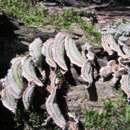Associations
provided by BioImages, the virtual fieldguide, UK
In Great Britain and/or Ireland:
Fungus / internal feeder
larva of Cis bilamellatus feeds within fruitbody of Trichaptum abietinum
Fungus / feeder
female micropter of Hoplothrips polysticti feeds on live fruitbody of Trichaptum abietinum
Remarks: season: 2-6,8-9
Fungus / feeder
larva of Hoplothrips unicolor feeds on live fruitbody of Trichaptum abietinum
Remarks: season: 2-11
Other: sole host/prey
Fungus / saprobe
fruitbody of Skeletocutis carneogrisea is saprobic on dead fruitbody of Trichaptum abietinum
Other: major host/prey
Foodplant / saprobe
fruitbody of Trichaptum abietinum is saprobic on fallen, dead branch (large) of Pinus sylvestris
Other: major host/prey
Foodplant / saprobe
fruitbody of Trichaptum abietinum is saprobic on dead, felled, stacked trunk of Pinopsida
Foodplant / saprobe
fruitbody of Trichaptum abietinum is saprobic on dead, felled, stacked trunk of Larix
Other: major host/prey
Foodplant / saprobe
fruitbody of Trichaptum abietinum is saprobic on dead, felled, stacked trunk of Picea
Other: major host/prey
Foodplant / saprobe
fruitbody of Trichaptum abietinum is saprobic on Fagus
Other: unusual host/prey
Foodplant / saprobe
fruitbody of Trichaptum abietinum is saprobic on dead, felled, stacked trunk of Pinus
Other: major host/prey
Fungus / internal feeder
Zilora ferruginea feeds within fruitbody of Trichaptum abietinum
Comprehensive Description
provided by North American Flora
Coriolus abietinus (Dicks.) Quel. Ench. Fung. 175. 1886
Boletus abietinus Dicks. PI. Crypt. Brit. 3 : 21. 1793.
Boletus incarnatus Schum. Enum. PI. Saell. 2 : 391. 1803.
Polyporus parvulus Schw. Trans. Am. Phil. Soc. II. 4: 157. 1832. (Type from Pennsylvania.)
? Polyporus pargamenus Fries, Epicr. Myc. 480. 1838. (Type from arctic North America.)
Polysiiciuspusio-SQ.cc. & Cub. in Sacc. Syll. Fung. 6 : 265. 1888.
Pileus effused-reflexed, the reflexed portion thin, tough, flexible to nearly rigid, 0.5-1.5 X 1-3X0.05-0.1 cm. ; surface obsoletely zonate, grayishwhite, villose; margin thin, undulate to lobed, fimbriate with age, incurved on drying : context very thin, white, membranous ; tubes uneven, irregular, soon becoming irpiciform, mouths variable in size, 2-3 toa mm., edges thin, lacerate-dentate, unequal, pallid or violet, fading with age, somewhat flesh-tinted in dried specimens: spores globose, smooth, hyaline, 4.5-5.5 /i; hyphae 7^; cystidia none.
Type locality : England.
Habitat : Decaying coniferous trunks.
Distribution ; Northerij hemisphere.
- bibliographic citation
- William Alphonso MurrilI, Gertrude Simmons BurIingham, Leigh H Pennington, John Hendly Barnhart. 1907-1916. (AGARICALES); POLYPORACEAE-AGARICACEAE. North American flora. vol 9. New York Botanical Garden, New York, NY
Trichaptum abietinum: Brief Summary
provided by wikipedia EN
Trichaptum abietinum is a species of poroid fungus in the order Hymenochaetales. It is saprophytic, growing from dead conifer wood.
The white-gray cap is 1–4 cm wide and usually no more than .5 thick, shelved and fanlike, with brownish and leathery flesh. The spores are white, cylindrical, and smooth.
The species is inedible.
Similar species include Trichaptum biforme, Bjerkandera adusta, and Trametes versicolor.
- license
- cc-by-sa-3.0
- copyright
- Wikipedia authors and editors

